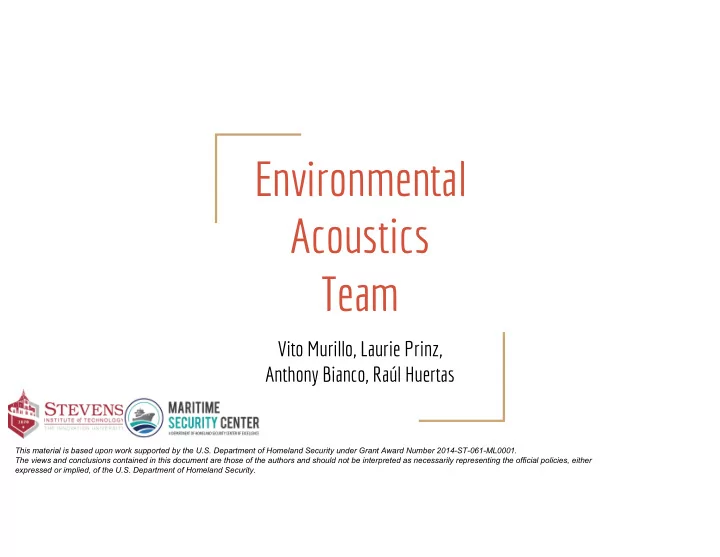

Environmental Acoustics Team Vito Murillo, Laurie Prinz, Anthony Bianco, Raúl Huertas This material is based upon work supported by the U.S. Department of Homeland Security under Grant Award Number 2014-ST-061-ML0001. The views and conclusions contained in this document are those of the authors and should not be interpreted as necessarily representing the official policies, either expressed or implied, of the U.S. Department of Homeland Security.
Overview 1. The A Team 2. Objectives and Implications 3. Equipment 4. Calibration and dBA 5. U.S. Merchant Marine Academy 6. Penn Plaza 7. Anechoic Chamber 8. Hoboken Pier 9. Conclusion
The A Team Alexander Sutin ● Mentor ○ Yegor Sinelnikov ● Environmental Acoustics Mentor ○ Vito Murillo ● Project Manager, Programming support, Writer support ○ Anthony Bianco ● Matlab and Equipment Technician ○ Laurie Prinz ● Data Organizer and Writer ○ Raúl Huertas ● Matlab and Equipment Support ○
Environmental Acoustics Objective The objectives of the Environmental Acoustics team were to: ● Collect empirical data from several ○ locations (Penn Plaza, Acoustic Chamber, USMMA, Hoboken Pier). ○ Determine sound pressure level. ○ ○ Identify sound events and sound ○ sources. ○ Detect acoustic signatures over ○ distance.
Implications of our research Characterize urban noise in spectral and temporal domains. ● Extract specific event acoustic signatures. ● Assess the ability to detect specific events that could potentially be ● harmful in urban and maritime environments.
Equipment •Zoom F8 Multitrack •Behringer B-5 •MatLab 2015a •Digital Sound Level Meter •ND9 Sound Calibrator
What is dBA? dBA is the resulting unit of sound ● pressure level after the A-Weighting has been applied. ● This process of weighting different ● frequencies results in a unit that is more representative of the perception of human hearing.
Determining Calibration Microphones convert Pascals from ● sound to Volts to be recorded as signal. The Pressure Calibration Factor was ● used to correct all microphone Sound Pressure Level readings to be in line with the Digital Sound Level Meter. .
Calibration Verif ication Plo t
Experiments United States ● Merchant Marine Academy Penn Plaza Pavilion ● Stevens Institute of ● Technology Anechoic Chamber Hoboken Pier Joint ● Research
United States Merchant Marine Academy Objective was to observe acoustic ● signature of a boat at different distances. Data collected: ● 11 Recordings (28 minutes) ○ 18.8 GB of Audio and Spectrogram ○ synchronization GPS Track ○
Boat Detection Recording 10 Upwind Time: 10 - 40 seconds NFFT: 8192 Frequency Range: 0 to 2 kHz dB Range: 0 to 100 dB *Boat is 99 meters away.
Time: 360 - 390 seconds NFFT: 8192 Frequency Range: 0 to 2 kHz dB Range: 0 to 100 dB * Frequencies from 0.4 kHz and up begin to fade away around 385 seconds. * Boat is 533 meters away.
GPS Track
Penn Plaza Pavilion The objective was to record urban noise. ● Data collected: ● 11 recordings (110 minutes) ○ 78.1 GB of Audio and Spectrogram ○ synchronization
Location * Precise measurements were taken of the surroundings. * Distances to buildings, streetlight intervals etc.
Data Gathered
Sound Pressure Level vs. Time
Police Sirens at Penn Plaza
Anechoic Chamber The objective was to isolate the ● acoustic signature of specific objects. Data collected: ● 16 recordings (20 minutes) ○
GunShot
Scream Male yelling Female yelling
Hoboken Pier The objective was to collect ● empirical data that could later be synchronized with Buoy Team’s data. Data collected: ● 9 recordings (3.8 hours) ○
Helicopter
Conclusion Four successful research experiments. ● ● Sound pressure levels determined. ● ● Specific acoustic signatures were identified. ● ● Detection of an acoustic signature over ● distance was achieved.
Thank you.
Recommend
More recommend